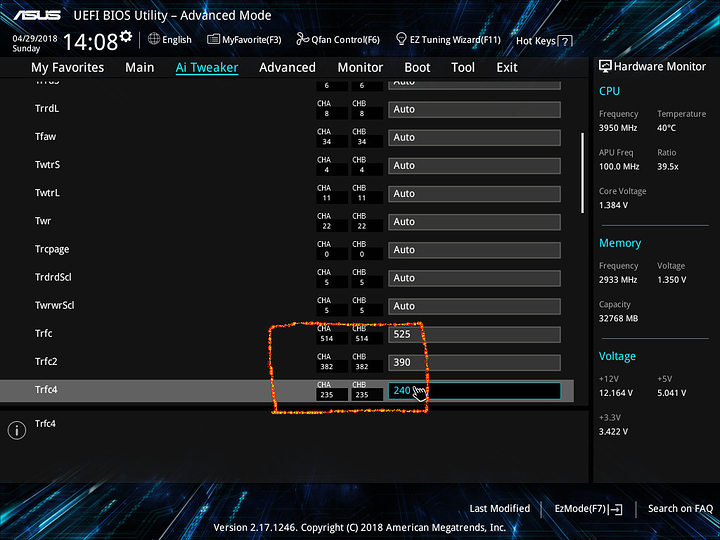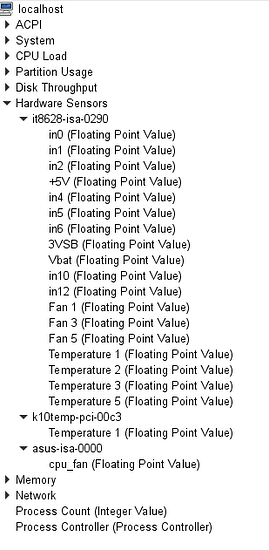Forgot to reply myself. I also updated to 4008. 32GB Hynix still running at 3000. I did manage to boot at 3200 using Ryzen DRAM Calculator timings but it froze twice in a row almost immediately. Didn’t feel like pushing voltage so leaving it at 3000 with tighter timings works for me just fine.
Running now stable 4008 with RAM at 2933MHz
Really tought I could get 3000MHz stable, but not just not quite.
The experience was different though
- I did not lost the FAN settings after the upgrade (Ok I did not forced default settings neither)
=> edited fan where reset but PWM was not enabled on non PWM capable - before I reset manually the settings I noticed thath contrary to previous BIOS, some auto settings where tighter than the Overclocking SPD value, that is remarquable !
3)I also tried the automatic settings for 3000Mhz, no success, while the 2933MHz automatic where quite looser
globally not a bad experience, as my memory still is not in the QVL …
I saw that Gigabyte X470 motherboard does supports it, though not the New ASUS 
More remarquable news with new BIOS
I do not now if the power saving improved greatly, or if the temperature sensors are now wrong under linux but the CPU temp. plunges in intactivity period
see a graph showing light activity (one browser tab open, then closed)

the ambiant temp. is about 20°C
Activity (6 VM opened and checking for update) temp. look normal
let me know if you also see this, maybe we will save some power 
Are you running a 2700X on this board? Thinking about upgrading and getting rid of a superfluous watercooler with the 1700X at the same time (too much junk hanging around).
hello Steinwerks
Noenken is, I beleive, running a 2700 on this board,
For my part I still am with my 1700x oveclocked to 3,95GHz at 1.35V with NOCTUA NH-12S
KR
Domi
I’m actually running the 2700 in my ITX system but I still have work to do on that one. I am running a 1700 @3.8 GHz with a fury but that rig is not at home and will stay like that. The second one is curruntly running a 1600X, I might replace that base system completely. And then there is the Taichi Ultimate that I am waiting for…
Yeah, fist world problems…
Damn, was hoping to hear how the new CPU’s were doing in the older board. Oh well.
JFYI - @Azulath is running a 2700x in an ASRock x370 Taichi, as noted here: Ryzen Pre-Week 25 fabrication RMA issue
Yeah that’s true. Thus far, it works without any problems 
XFR seems to work as well, it clocks itself up to 4.3 (almost 4.4) GHz.
That’s great news! Wasn’t sure how effective it would be on X370, but not having to replace the motherboard would be nice if I decide to upgrade.
I think it comes down to whether the mainboard’s VRM are able to deliver enough power or not. (And the BIOS ofc  ). As far as I can remember, the Taichi had the best VRMs when compared to the other X370 boards, with Asus boards following. Which is why you should be fine with the Prime. That being said, I haven’t tortured tested it or anything, it just noticed the clock speed going up the same amount as on X470 boards according to reviews.
). As far as I can remember, the Taichi had the best VRMs when compared to the other X370 boards, with Asus boards following. Which is why you should be fine with the Prime. That being said, I haven’t tortured tested it or anything, it just noticed the clock speed going up the same amount as on X470 boards according to reviews.
The next thing I’ll do with the 2700X is undervolting it - once I have results I’ll create a corresponding thread on this forum.
Yet another new BIOS! 4011 this time.
Again, notes are trash, same as before but SMU 43.18? Not sure what that is…
Hello Sceps,
I am running Linux OpenSuse Leap 42.3 with XFce windows manager and up-to-date “Kernel:Stable”
The pictures are snapshots of Ksysguard ( linux monitoring tool interface ), that I took with Gimp.
The “Sensors” and “monitoring-plugins-sensors” packages needs to be installed and configured for the it8628 chipset, it is not too complicated to do, althought not all the measuring points work 
here the list of point provided
temp1 is the CPU,
KR
Domi
@Steinwerks thanks for the update notice, yet another one
As for the SMU update I would assume this would include the security modules firmware fixes for the issues raised in a spectacular maner by CTS and claimed “unfixable”
AMD released the fixes 3 weeks ago for the integrators
https://www.amd.com/en/corporate/security-updates
=> secure processor, PSP escalation etc…
just read an update from phoronix, seems that the AGESA update benefits the Ryzen + 2700x performance, on Linux, nothing about our good “old 1700x” though 
A pitty that Asus do not communicate better the release notes, keeps us guessing
KR
Ok, did install the 4011
No worry, no regression.
Again almost thought that 3000MHz could be stable, but quickly gave up at first quirk, so I am back my prevous settings and to a stable 2933MHz
as for the power management I will need a few days to have a better view as the ambient temp is now 2°c up, still a nice idle low temp in the 28°C but for the moment it seems to drop a little bit slower
KR
Domi
How do you define stable / not stable?
Nice temps.
I know I wasn’t asked but this would be my answer.
If I can make the thing crash or hit limits just by running some programs, it’s not good enough. I am running mprime -t (prime95 kind of), memtest, a blender build from git using pacman (that was just to check for “segmentation fault” error), unigine valley… stuff like that to stress components. Is that realistic? No, mostly not. But that is the point. If the system can handle those unrealistic workloads, anything else will be running fine, even over long periods of time.
As a side note: I am currently running 4x8GB Kingston 2400MHz ECC DDR4 (micron stuff I think) without any problems on the prime and ECC seems to be working just fine. I am on BIOS 3805 on that one, I will update it shortly.
What do you mean by “hit limits”?
How long do you run mprime? Do you aim for no errors on it running indefinitely?
I just finished an ITX build and I tried to make a R9 nano work in that but it just gets too hot. Even modding the cooling didn’t help. So, a thermal limit would be an example.
Well, indefinitely is … a bit long. When I build a system generally I just let the first couple tests pass. Later with an installed OS I let it run at least until temps stop climbing, most times that means simply over night.


